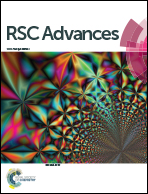Influence of solvent mixture on nucleophilicity parameters: the case of pyrrolidine in methanol–acetonitrile†
Abstract
The course of organic chemical reactions is efficiently modelled through the concepts of “electrophiles” and “nucleophiles” (meaning electron-seeking and nucleus-seeking reactive species). On the one hand, an advanced approach of the correlation of the nucleophilicity parameters N and electrophilicity E has been delivered from the linear free energy relationship log k (20 °C) = s(N + E). On the other hand, the general influence of the solvent mixtures, which are very often employed in preparative synthetic chemistry, has been poorly explored theoretically and experimentally, to date. Herein, we combined experimental and theoretical studies of the solvent influence on pyrrolidine nucleophilicity. We determined the nucleophilicity parameters N and s of pyrrolidine at 20 °C in CH3OH/CH3CN mixtures containing 0, 20, 40, 60, 80 and 100% CH3CN by kinetic investigations of their nucleophilic substitution reactions to a series of 2-methoxy-3-X-5-nitrothiophenes 1a–e (X = NO2, CN, COCH3, CO2CH3, CONH2). Depending on the resulting solvation medium, the N parameters range from 15.72 to 18.32 on the empirical nucleophilicity scale of Mayr. The nucleophilicity parameters N first evolve linearly with the content of acetonitrile up to 60% CH3CN by volume, but is non linear for higher amounts. We designed a general computation protocol to investigate the solvent effect at the atomistic scale. The nucleophilicity in solvent mixtures was evaluated by combining classical molecular dynamic (MD) simulations of solvated pyrrolidine and a few density functional theory (DFT) calculations of Parr nucleophilicity. The pyrrolidine theoretical nucleophilicity 1/ω obtained in various CH3OH/CH3CN mixtures are in excellent agreement with Mayr's nucleophilicity (N) parameters measured. Analyses of the molecular dynamic trajectories reveal that the decrease of the nucleophilicity in methanol rich mixtures arises predominantly from the solvation of the pyrrolidine by methanol molecules through strong hydrogen bonds. Last, we proposed a simple model to predict and accurately reproduce the experimentally obtained nucleophilicity values.



 Please wait while we load your content...
Please wait while we load your content...